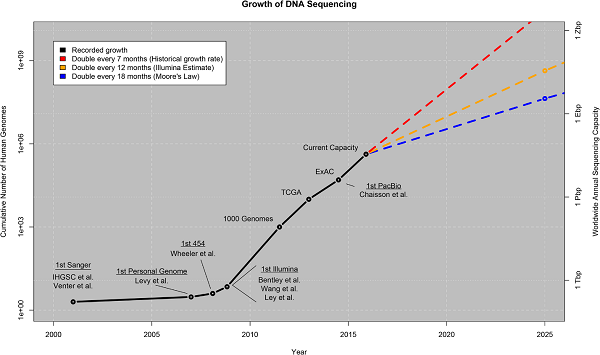In this week’s Sponsored Post, Bill Mannel, Vice President & General Manager of HPC Segment Solutions and Apollo Servers, Data Center Infrastructure Group at Hewlett Packard Enterprise, explains how next-generation sequencing is altering the patient care landscape.
In this competitive global marketplace, organizations of every size and industry are striving to achieve greater speed, efficiency, accuracy, and savings. IT departments are rapidly adopting powerful new technologies in order to enhance operational processes and boost compute resources, as customers demand more personalized services at reduced costs.

Bill Mannel, VP & GM of HPC & Big Data Business Unit at HPE
Advancements in high-performance computing have led to major scientific breakthroughs and technological innovation. The life sciences industry in particular is realizing the effects of this massive paradigm shift – with improvements to each stage of the research and development process and patient care.
This new generation of precision medicine is driving significant improvements to the field of genomics.
Over the past decade, life sciences organizations have undergone a total IT transformation. Clinical testing which was once expensive and time-consuming can now be completed quickly and cost-effectively, thanks to cutting-edge software and industry-specific tools. Today’s scientists and healthcare professionals are leveraging these HPC solutions to solve the world’s greatest health problems and accelerate the diagnoses and treatment of a variety of medical conditions.
This new generation of precision medicine is driving significant improvements to the field of genomics. Genomic sequencing – or “decoding” the human genome – helps scientists understand a person’s genetic makeup, making it possible to pinpoint genes that direct growth, development, and maintenance of the entire body. Recent progress in computing technologies allows researchers to map extensive chains of the human genome, and analyze the DNA of healthy individuals in order to identify chromosomes or mutations that could develop into a genetic condition.
These medical breakthroughs will not only improve our ability to treat diseases, but also to predict and even prevent diseases before they occur. But the cost has been high.
[clickToTweet tweet=”Genomic sequencing is helping scientists treat, predict, and even prevent genetic diseases.” quote=”Genomic sequencing is helping scientists treat, predict, and even prevent genetic diseases.”]
Next-generation sequencing (NGS) tools produce vast quantities of genetic data which poses a growing number of challenges to life sciences organizations. Accelerating analytics, providing adequate storage and memory capacity, speeding time-to-solution, reducing costs are major concerns for IT department operating on traditional computing systems.
Thanks to advancements in HPC, NGS technology delivers scalability and speed like never before. Genomic workloads that once cost upwards of $1 billion and took years to complete now cost $1,245 and can be sequenced in under a day. Additional benefits of NGS applications include:
- Identifying rare genetic mutations and variations
- Genetic profiling of cancer-causing mutations
- Deeper analysis to develop personalized treatment plans
- Predictive medicine enabling a historically proven course of treatment
- Medicines intelligently prescribed based on patients’ genetic tendencies
The proliferation of NGS is producing explosive volumes of genetic data, providing widespread access to historical medical data. As genomic information becomes more readily available, researchers will be able to improve the speed and accuracy of genetic mapping in order to build more detailed patient health profiles. According to the PLoS Biology journal, as many as two billion human genomes could be sequenced by 2025.

As the need for genomic sequencing continues to rise, organizations are seeking a new style of IT in order to keep pace. HPC technologies specifically designed for NGS can help organizations perform genome sequencing faster, while delivering scalability, ease of installation, and cost-savings.
These innovations will continue to play a key role in patient health, as the life sciences industry strives to analyze, share, and enact on growing levels of genomic data. To learn more about the incredible health benefits of NGS, I invite you to follow me on Twitter at @Bill_Mannel.
This guest article was submitted by Bill Mannel, Vice President & General Manager of HPC Segment Solutions and Apollo Servers, Data Center Infrastructure Group at Hewlett Packard Enterprise.



